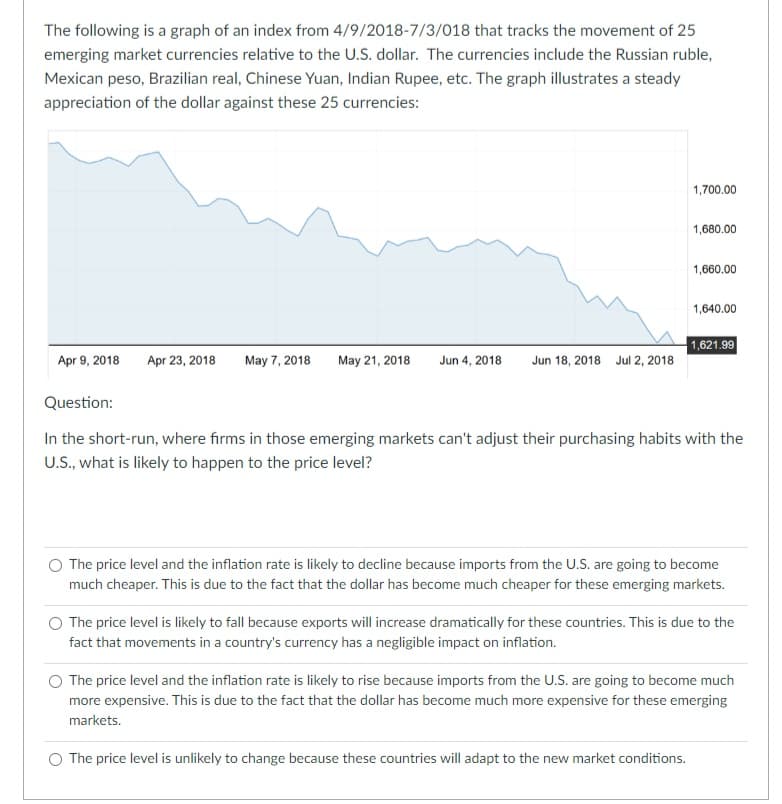The following is a graph of an index from 4/9/2018-7/3/018 that tracks the movement of 25 emerging market currencies relative to the U.S. dollar. The currencies include the Russian ruble, Mexican peso, Brazilian real, Chinese Yuan, Indian Rupee, etc. The graph illustrates a steady appreciation of the dollar against these 25 currencies: Apr 9, 2018 Apr 23, 2018 May 7, 2018 May 21, 2018 Jun 4, 2018 Jun 18, 2018 Jul 2, 2018 1,700.00 1,680.00 1,660.00 1,640.00 1,621.99 Question: In the short-run, where firms in those emerging markets can't adjust their purchasing habits with the U.S., what is likely to happen to the price level? O The price level and the inflation rate is likely to decline because imports from the U.S. are going to become much cheaper. This is due to the fact that the dollar has become much cheaper for these emerging markets. The price level is likely to fall because exports will increase dramatically for these countries. This is due to the fact that movements in a country's currency has a negligible impact on inflation. The price level and the inflation rate is likely to rise because imports from the U.S. are going to become much more expensive. This is due to the fact that the dollar has become much more expensive for these emerging markets. O The price level is unlikely to change because these countries will adapt to the new market conditions.
The following is a graph of an index from 4/9/2018-7/3/018 that tracks the movement of 25 emerging market currencies relative to the U.S. dollar. The currencies include the Russian ruble, Mexican peso, Brazilian real, Chinese Yuan, Indian Rupee, etc. The graph illustrates a steady appreciation of the dollar against these 25 currencies: Apr 9, 2018 Apr 23, 2018 May 7, 2018 May 21, 2018 Jun 4, 2018 Jun 18, 2018 Jul 2, 2018 1,700.00 1,680.00 1,660.00 1,640.00 1,621.99 Question: In the short-run, where firms in those emerging markets can't adjust their purchasing habits with the U.S., what is likely to happen to the price level? O The price level and the inflation rate is likely to decline because imports from the U.S. are going to become much cheaper. This is due to the fact that the dollar has become much cheaper for these emerging markets. The price level is likely to fall because exports will increase dramatically for these countries. This is due to the fact that movements in a country's currency has a negligible impact on inflation. The price level and the inflation rate is likely to rise because imports from the U.S. are going to become much more expensive. This is due to the fact that the dollar has become much more expensive for these emerging markets. O The price level is unlikely to change because these countries will adapt to the new market conditions.
Chapter1: Making Economics Decisions
Section: Chapter Questions
Problem 1QTC
Related questions
Question

Transcribed Image Text:The following is a graph of an index from 4/9/2018-7/3/018 that tracks the movement of 25
emerging market currencies relative to the U.S. dollar. The currencies include the Russian ruble,
Mexican peso, Brazilian real, Chinese Yuan, Indian Rupee, etc. The graph illustrates a steady
appreciation of the dollar against these 25 currencies:
Apr 9, 2018
Apr 23, 2018 May 7, 2018 May 21, 2018
Jun 4, 2018 Jun 18, 2018 Jul 2, 2018
1,700.00
1,680.00
1,660.00
1,640.00
1,621.99
Question:
In the short-run, where firms in those emerging markets can't adjust their purchasing habits with the
U.S., what is likely to happen to the price level?
The price level and the inflation rate is likely to decline because imports from the U.S. are going to become
much cheaper. This is due to the fact that the dollar has become much cheaper for these emerging markets.
The price level is likely to fall because exports will increase dramatically for these countries. This is due to the
fact that movements in a country's currency has a negligible impact on inflation.
The price level and the inflation rate is likely to rise because imports from the U.S. are going to become much
more expensive. This is due to the fact that the dollar has become much more expensive for these emerging
markets.
O The price level is unlikely to change because these countries will adapt to the new market conditions.
Expert Solution
This question has been solved!
Explore an expertly crafted, step-by-step solution for a thorough understanding of key concepts.
This is a popular solution!
Trending now
This is a popular solution!
Step by step
Solved in 3 steps

Knowledge Booster
Learn more about
Need a deep-dive on the concept behind this application? Look no further. Learn more about this topic, economics and related others by exploring similar questions and additional content below.Recommended textbooks for you


Principles of Economics (12th Edition)
Economics
ISBN:
9780134078779
Author:
Karl E. Case, Ray C. Fair, Sharon E. Oster
Publisher:
PEARSON

Engineering Economy (17th Edition)
Economics
ISBN:
9780134870069
Author:
William G. Sullivan, Elin M. Wicks, C. Patrick Koelling
Publisher:
PEARSON


Principles of Economics (12th Edition)
Economics
ISBN:
9780134078779
Author:
Karl E. Case, Ray C. Fair, Sharon E. Oster
Publisher:
PEARSON

Engineering Economy (17th Edition)
Economics
ISBN:
9780134870069
Author:
William G. Sullivan, Elin M. Wicks, C. Patrick Koelling
Publisher:
PEARSON

Principles of Economics (MindTap Course List)
Economics
ISBN:
9781305585126
Author:
N. Gregory Mankiw
Publisher:
Cengage Learning

Managerial Economics: A Problem Solving Approach
Economics
ISBN:
9781337106665
Author:
Luke M. Froeb, Brian T. McCann, Michael R. Ward, Mike Shor
Publisher:
Cengage Learning

Managerial Economics & Business Strategy (Mcgraw-…
Economics
ISBN:
9781259290619
Author:
Michael Baye, Jeff Prince
Publisher:
McGraw-Hill Education